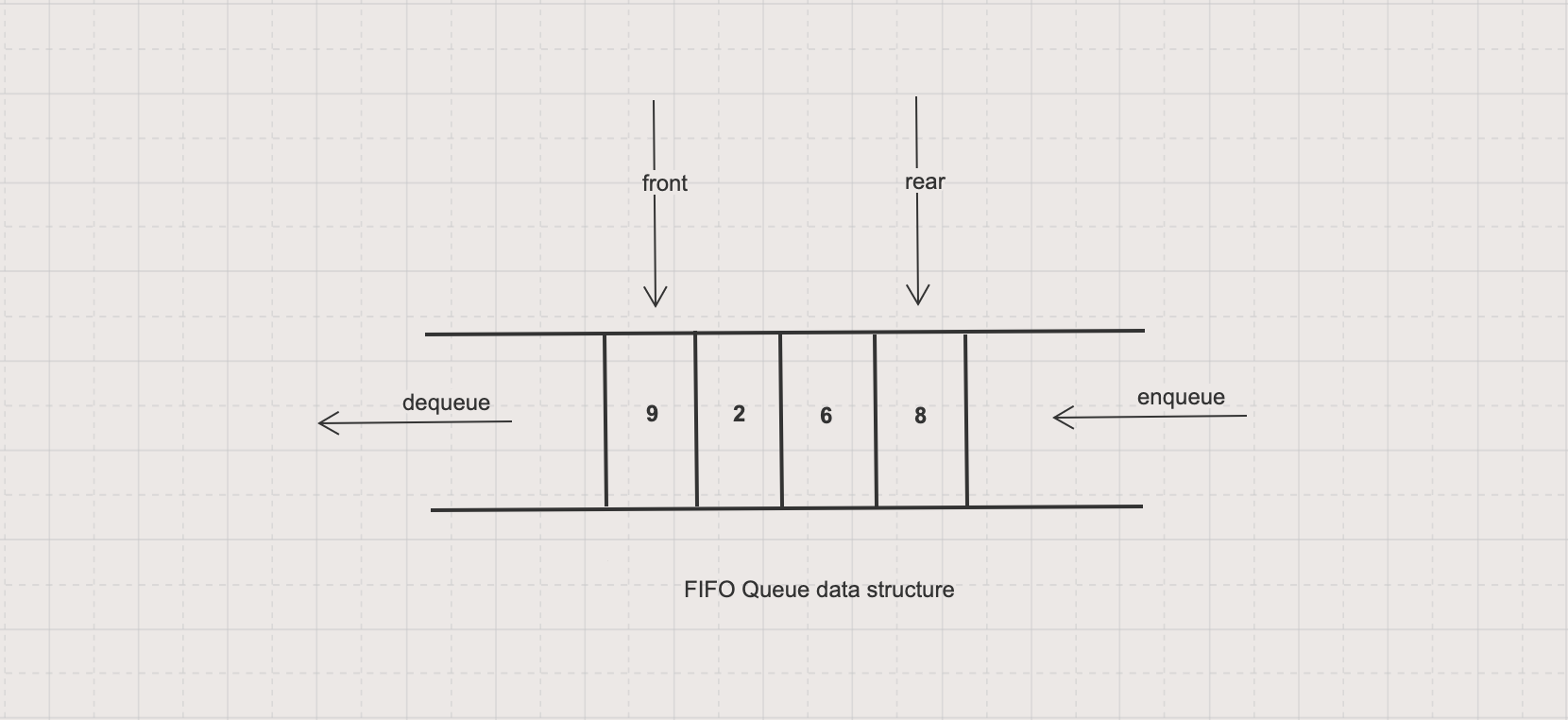There are multiple types of Queue data structure. In this article, we will learn about FIFO, Double-Ended, and Priority Queue. We will also implement some common Queue operations including
Enqueue: adds an item into a queue
Dequeue: retrieves and removes an item from a queue
FIFO Queue
FIFO queue data structure is a collection of items in First In First Out (FIFO) order as items can only be added into the rear and removed from the front

You can implement a FIFO queue with either a linked list or an array. The following implementation example uses an array
import java.util.NoSuchElementException;
public class QueueByArray {
private int[] queue;
private int front;
private int rear;
public QueueByArray(int capacity) {
this.queue = new int[capacity];
this.front = 0;
this.rear = 0;
}
public void enqueue(int x) {
if (isFull()) {
throw new IllegalStateException();
}
queue[rear++] = x;
}
public int dequeue() {
if (isEmpty()) {
throw new NoSuchElementException();
}
return queue[front++];
}
public int front() {
if (isEmpty()) {
throw new NoSuchElementException();
}
return queue[front];
}
public boolean isEmpty() {
return front == rear;
}
public boolean isFull() {
return rear == queue.length;
}
public int size() {
return rear - front;
}
public static void main(String[] args) {
QueueByArray myQueue = new QueueByArray(3);
myQueue.enqueue(1);
myQueue.enqueue(2);
myQueue.enqueue(3);
System.out.println(myQueue.front()); // 1
System.out.println(myQueue.dequeue()); // 1
System.out.println(myQueue.front()); // 2
System.out.println(myQueue.size()); // 2
System.out.println(myQueue.isEmpty()); // false
System.out.println(myQueue.isFull()); // false
}
}
Double-Ended Queue (Deque)
Deque is a collection where items can be added to or removed from either at the front or rear
You can implement a deque with either an array or a doubly-linked list. The following implementation example uses an array
import java.util.NoSuchElementException;
public class DequeueByArray {
private int[] dequeue;
private int front;
private int rear;
public DequeueByArray(int capacity) {
this.dequeue = new int[capacity];
this.front = 0;
this.rear = 0;
}
public void enqueueFirst(int x) {
if (isFull()) {
throw new IllegalStateException();
}
for (int i = rear; i > front ; i--) {
dequeue[i] = dequeue[i-1];
}
dequeue[front] = x;
rear++;
}
public void enqueueLast(int x) {
if (isFull()) {
throw new IllegalStateException();
}
dequeue[rear++] = x;
}
public int dequeueFirst() {
if (isEmpty()) {
throw new NoSuchElementException();
}
return dequeue[front++];
}
public int dequeueLast() {
if (isEmpty()) {
throw new NoSuchElementException();
}
return dequeue[rear--];
}
public int front() {
if (isEmpty()) {
throw new NoSuchElementException();
}
return dequeue[front];
}
public int rear() {
if (isEmpty()) {
throw new NoSuchElementException();
}
return dequeue[rear-1];
}
public boolean isEmpty() {
return front == rear;
}
public boolean isFull() {
return rear == dequeue.length;
}
public int size() {
return rear - front;
}
public static void main(String[] args) {
DequeueByArray myQueue = new DequeueByArray(3);
myQueue.enqueueFirst(1);
myQueue.enqueueLast(2);
myQueue.enqueueFirst(3);
System.out.println(myQueue.front()); // 3
System.out.println(myQueue.dequeueFirst()); // 3
System.out.println(myQueue.front()); // 1
System.out.println(myQueue.size()); // 2
System.out.println(myQueue.isEmpty()); // false
System.out.println(myQueue.isFull()); // false
}
}
Priority Queue Data Structure
Priority Queue is a collection where items can be retrieved and removed by priority
You can implement a priority queue with either an array, a linked list, or a binary heap. The following implementation example uses a binary heap
public class PriorityQueueByHeap {
private MaxHeapByArray maxHeapByArray;
public PriorityQueueByHeap(int capacity) {
this.maxHeapByArray = new MaxHeapByArray(capacity);
}
public void enqueue(int x) {
maxHeapByArray.push(x);
}
public int dequeue() {
return maxHeapByArray.pop();
}
public int front() {
return maxHeapByArray.peek();
}
public static void main(String[] args) {
PriorityQueueByHeap myQueue = new PriorityQueueByHeap(5);
myQueue.enqueue(7);
myQueue.enqueue(2);
myQueue.enqueue(3);
myQueue.enqueue(1);
myQueue.enqueue(9);
System.out.println(myQueue.front()); // 9
System.out.println(myQueue.dequeue()); // 9
System.out.println(myQueue.front()); // 7
}
}
MaxHeapByArray is defined in Heap Data Structure
